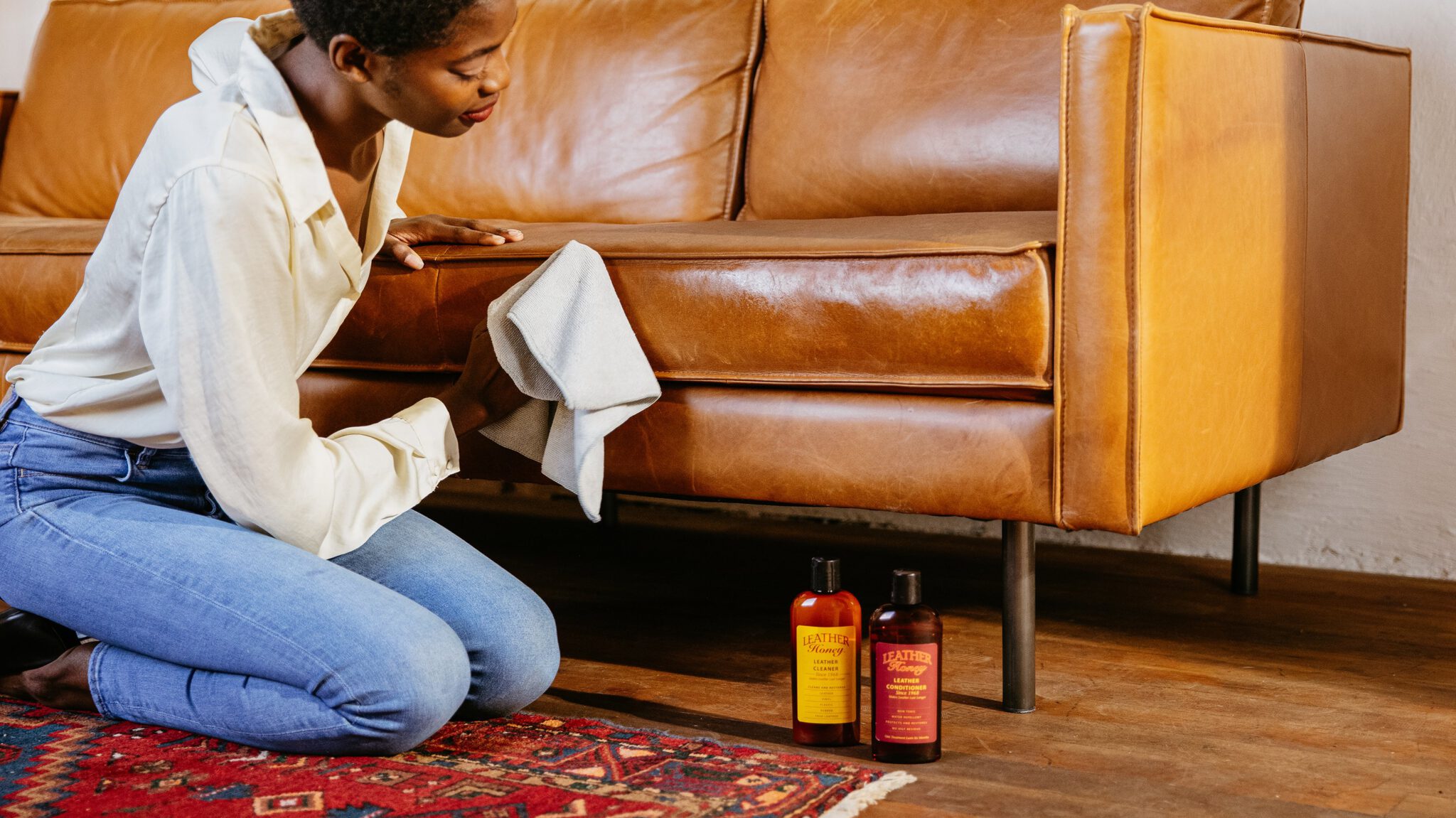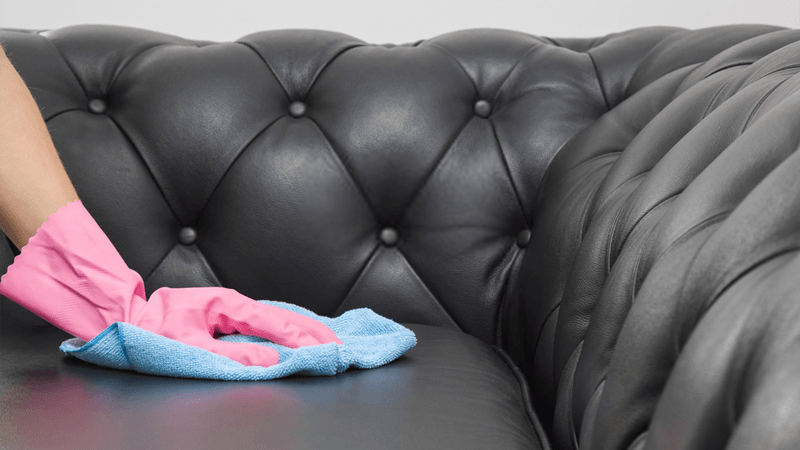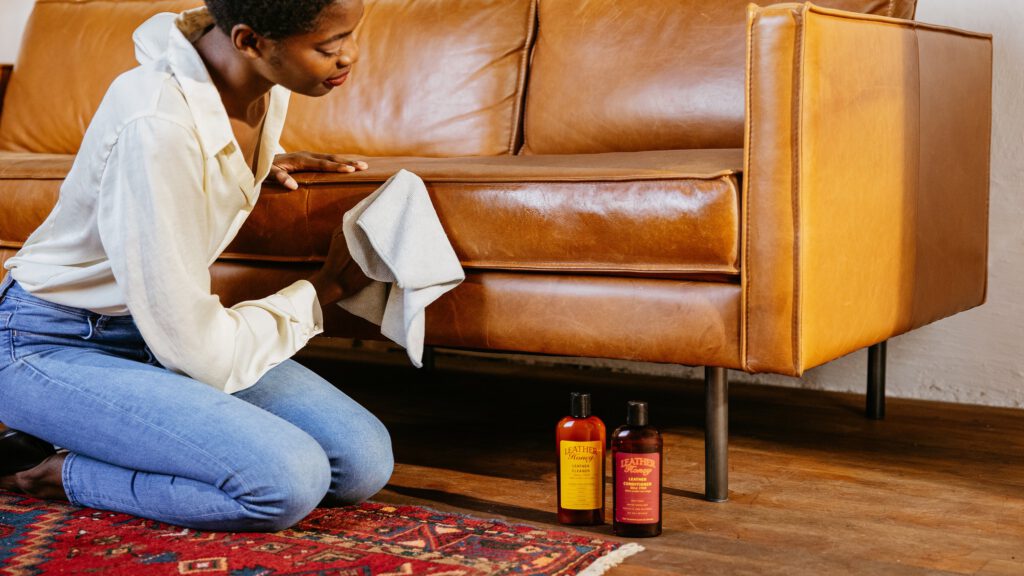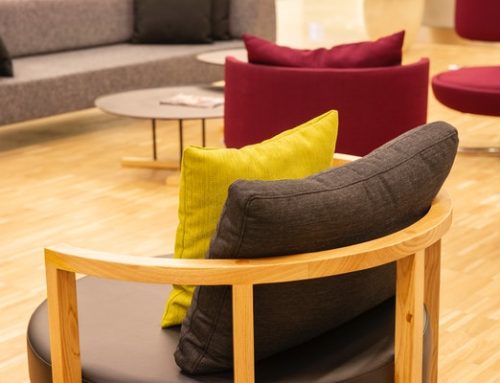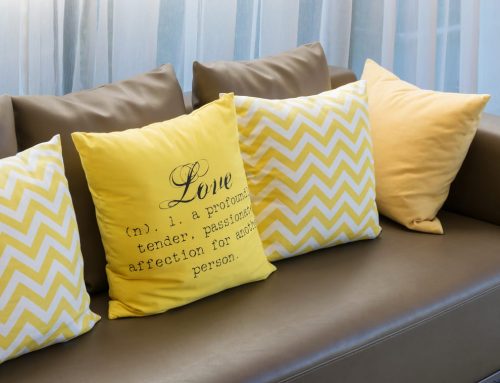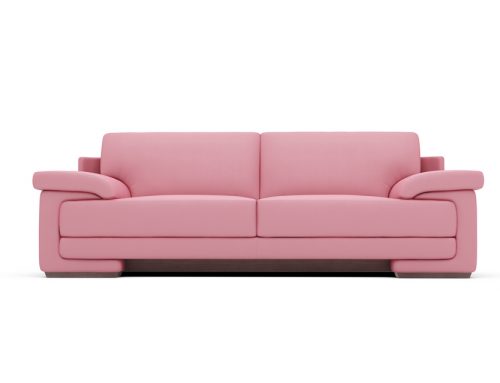A high-quality leather sofa can be a fantastic centrepiece for your living room. However, keeping the leather clean can be a bit tricky, especially with stubborn ink or grease stains. But it’s not just that. Even the simplest stains can turn the leather into a dull, cracked, and uncomfortable mess.
In this article, our upholstery cleaning experts go over the right way to clean leather sofa surfaces and what products to avoid at all costs.
Let’s jump right in!
How to Clean a Leather Sofa the Right Way (7 Tips and Tricks)
To safely clean a leather couch, you need to be mindful of the processes you do and the order that you follow. Ideally, you want to remove the stain with the least amount of scrubbing or chemicals added. If you’re feeling overwhelmed, take a look at our seven handy tips:
Start With a Vacuum/Wipe
As soon as something spills on the sofa. Don’t wait for it to spread and seep into the leather. First things first, remove all decorative items like throws and pillows from the sofa. You can clean those separately later on. Then, grab a clean microfiber cloth and try to limit the damage to a small area. There are two ways you can go about this. You can either wipe or dab the affected leather. If you spilled a large amount of something that’s particularly fluid, you might want to dab and hold on the spot for a minute or so to let the cloth absorb as much of the spillage as possible.
Meanwhile, if the incident was more of a viscous or crumbly material, it might be easier to wipe it up.
Next, to clean all the remaining particles, get your vacuum out and look for the crevice or the upholstery attachment that came with your vacuum. It’ll help you get to all the nooks and crannies to clear out any debris and junk. Once you’re done with that, take a dry microfiber cloth to wipe off any dust fallout. This prompt response might save you the hassle of doing a deep clean.
Do Test Patches
While all the methods we mention here are tried, it’s still a good idea to do test patches. When it comes to something as valuable as a genuine leather couch, it’s better to be safe than sorry! When you’re doing a test patch for a new cleaning product or a sponge, make sure you do it someplace small and hidden.
Ideally, the area should be square-like and around four inches long. If it’s too large, the test becomes pointless, and if it’s too small, you won’t get to see the result clearly. It might sound like a lot of unnecessary work, but once you settle on a method you like, you won’t have to do the test patch anymore. Obviously, you don’t have to do it for vacuuming or dry wiping as long as you use a soft cloth and appropriate vacuum setting. The “testing” tip applies to all the steps below.
Nitpick Your Cleaning Mixture
Now that you’ve vacuumed and wiped, it’s time to tackle the stained area. You’ll have to identify the staining intensity and act accordingly. For minor stains, start with lukewarm water only on a microfiber cloth. Sometimes, it’ll be enough to remove the remaining streaks. If not, you’ll have to move on to a cleaning solution. Depending on the nature of the staining, you’ll need different cleaning mixes. For instance, a cotton swab dipped in alcohol works best for ink stains.
Meanwhile, vinegar can be a gentle remover for darkened spots on light-coloured leather. Just remember to dilute it with equal parts warm water. When you’re done, use another clean cloth dampened with water only to clear up any vinegar residue since too much of it can dry out the leather. No matter what you do, never spill the cleaning mix directly onto the sofa. Always dampen a soft cloth and use it to wipe the surface.
Use Corn starch for Oily Spills
Some stains are going to be a bit more resilient, and they won’t clear up immediately with a cloth and a cleaning solution. Most commonly, grease and oil stains require more intricate care before you can restore the leather, especially if the lipids are already soaked up.
Get some baking soda or corn starch and sprinkle it over the stained area. Be careful, though. It might be too abrasive if you try to rub it into the leather. Just spread it out gently and let it sit overnight. With a dry cloth, wipe the excess powder off of the sofa. It should’ve absorbed the majority of the grease from the leather. If some staining still remains, you might need to go for a second round. It might also be useful to alternate the powder from baking soda to corn starch and vice versa.
Buff Scratches Out
In some cases, the issue isn’t with stains or discoloration at all but with scratched surfaces. There are no home remedies to clear up deep scratches that ruin the leather completely. However, you can deal with small scuffs by minimizing their appearance and keeping them from spreading deeper. Unlike wooden and metallic surfaces, you’ll have to avoid any abrasive paper to “buff” the surface. For leather, a chamois cloth works best to gently work the scuffs. You might even need to use a bit of petroleum jelly to lubricate and moisturize the leather a bit as you go. Remember that drying out is one of the causes of cracking in leathers!
Once again, it’s not recommended to apply petroleum jelly directly to the couch. Instead, add a small dab to a clean cloth and slowly buff it around in circular motions. You only need a very minuscule amount, so it’s better to start small before adding more. If you go overboard, you risk turning it into a grease stain. When you’re done, let it dry out completely before sitting on the sofa. You don’t want to unintentionally spread the petroleum jelly everywhere and turn the leather into a sticky mess!
Keep Leather Conditioner on Stand-By
Sometimes, a chamois cloth doesn’t cut it when it comes to finishing up leather furniture. You’ll have to go in with a conditioner for good measure. A good leather conditioner will lubricate the surface and reduce friction. This helps protect the sofa against wear and tear, especially after a cleaning session. It can also be a good product to top up the cleaned sofa and keep it looking shiny and clean longer. This is because it enriches the patina’s colour and texture, which adds more character to the leather. Some people prefer using a specialized conditioner, while others might lean towards crafty mixtures over store-bought ones.
Neatsfoot oil is one of those handy products that can substitute conditioner for wood and leather. However, when applying oils to leather, make sure you don’t add any acidic sources like lemons since acidity can wear out the surface faster. Hair conditioner is also a commonly used product. It’s not the worst thing to use for your leather furniture, but its efficiency will vary a lot depending on how waxy the formula is. Keep in mind that the scent will linger, too!
Consult a Professional Cleaner
We get that this is a step that we all probably like to avoid since it’s expensive and time-consuming. However, in some instances, the staining might be beyond your capabilities. If the leather is deeply cut or the staining is spread all over the sofa, it might be time to leave it to the professionals. It’s also a good idea to get professional help when sanitizing a second-hand sofa. You never know what germs lingered in there over the years!
So, if all else fails, make sure you have a list of reputable sofa cleaning services in your area to call for help. Also, you can find some general upholstery cleaning tips here.
What to Avoid When Cleaning a Leather Sofa
After nailing your basics down, you might be wondering if you can alternate any of the products we mentioned earlier with what you have on hand. The issue here is that sometimes swapping the recommended solutions with untested ones can backfire.
To stay on the safe side, take a look at this list of products to avoid when cleaning your leather sofa:
Ammonia
Sure, ammonia does a very good job cleaning stubborn stains. However, ammonia-based cleaning products are too harsh to use safely over leather furniture. All in all, we recommend that you steer clear of any cleaning solution with ammonia in it. While it’ll remove the stain, it’ll also risk ruining the leather surface and drying them out.
Bleach
Much like ammonia, chlorine bleach can do more harm than good, even when you dilute it and use it with a cloth. However, it can be safe to use a solution of oxalic acid bleach on leather furniture as long as you mix in a 1:6 ratio with water and let it dry adequately.
Acetone
Acetone can strip the leather of moisture and pigment. Yet, it’s a notoriously good way to remove strong glues. If you absolutely need to use acetone as a part of a restoration, get professional help. You’ll probably have to re-dye the stained part later on.
Marker
It sounds weird, but some people tend to believe that using a marker to draw over a discoloured stain might obscure it. Unfortunately, that’s not how it works. Not only is it rare to find a marker that matches the leather, you still need to factor in how the colour is going to change over the discoloured spot. It could also smear or bleed into the fabric.
Boiling Water
Hot water can cause the leather to shrink by evaporating the oils and sucking out the moisture with it. Moreover, it can lead to brittle surface that crack easily, collect dust, and feel very unpleasant to the touch. Use warm or lukewarm water to avoid this risk.
Is Leather Furniture Worth It?
Now, after a long list of dos and don’ts, you might be feeling a bit overwhelmed. Leather furniture maintenance will do that to a person. However, leather tends to be worth the effort you put into caring for it. A well-maintained leather couch will live a lifetime to add a classy touch to your living room. Here are some of the highlights of owning a leather furnishing piece at home:
Longevity
If you give it the attention it deserves, your sofa could last anywhere between 15 to 20 years! For the most part, you need to protect it from extreme temperature changes, condition it regularly, and schedule a deep clean once or twice annually. Of course, it all depends on the quality of the leather, to begin with. Generally, it’s better to get full-grain leather, but bonded ones can still give you a good bang for your bucks.
Aesthetic
A high-quality leather sofa can dramatically change the entire aesthetic of any given room, and you don’t even have to settle for the classic brown dye when there are so many alternatives. Once you blend in the colour palette with the right accents, you can end up with a warm, welcoming, and cozy atmosphere.
Allergy-Friendly
Going for a leather sofa might be a smart choice if your seasonal allergies flare up easily since it won’t hold pollen and dust like a regular upholstery sofa would. The same applies to pet fur, which is very simple to brush or wipe off the leather with a damp cloth.
Final Thoughts
Figuring out the right way to clean leather couch surface with stubborn stains can be tricky at first. However, it all comes down to vacuuming out any visible spills or crumbles before using a mild cleaning solution with a soft cloth. To preserve the leather’s original lustre, make sure you dust the surface periodically and use a suitable conditioner to restore the moisture. When in doubt, remember to do patch tests on the backside of the sofa. It’ll help you avoid any unwelcome incidents.

